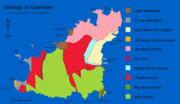
Geology of Guernsey
Encyclopedia

Augen
Augen are large, lenticular eye-shaped mineral grains or mineral aggregates visible in some foliated metamorphic rocks. In cross section they have the shape of an eye.Feldspar, quartz, and garnet are common minerals which form augen....
gneiss
Gneiss
Gneiss is a common and widely distributed type of rock formed by high-grade regional metamorphic processes from pre-existing formations that were originally either igneous or sedimentary rocks.-Etymology:...
of granitic composition containing potassium
Orthoclase
Orthoclase is an important tectosilicate mineral which forms igneous rock. The name is from the Greek for "straight fracture," because its two cleavage planes are at right angles to each other. Alternate names are alkali feldspar and potassium feldspar...
feldspar
Feldspar
Feldspars are a group of rock-forming tectosilicate minerals which make up as much as 60% of the Earth's crust....
. This was formed from a granite dated at using U-Pb dating on zircon
Zircon
Zircon is a mineral belonging to the group of nesosilicates. Its chemical name is zirconium silicate and its corresponding chemical formula is ZrSiO4. A common empirical formula showing some of the range of substitution in zircon is 1–x4x–y...
grains. A foliated Perelle quartz diorite (also called Perelle Gneiss), occurs in the centre and west of the island. This is a calc-alkaline tonalitic rock. The foliation was formed around . Rafts of metamorphosed sediments, older than the gneiss are embedded between them.
The Pleinmont Formation consists of metamorphosed sediments is of unknown age. It is named after Pleinmont Point on the south west tip of the Island. These are from the Brioverian succession.
The earlier rocks, known as the pre-Cadomian basement, were then deformed in the Cadomian Orogeny
Cadomian Orogeny
The Cadomian Orogeny was a tectonic event or series of events in the late Neoproterozoic, about 650-550 Ma, which probably included the formation of mountains. This occurred on the margin of the Gondwana continent, involving one or more collisions of island arcs and accretion of other material at a...
. It is unknown whether this is part of a craton
Craton
A craton is an old and stable part of the continental lithosphere. Having often survived cycles of merging and rifting of continents, cratons are generally found in the interiors of tectonic plates. They are characteristically composed of ancient crystalline basement rock, which may be covered by...
, a detached piece of Gondwana
Gondwana
In paleogeography, Gondwana , originally Gondwanaland, was the southernmost of two supercontinents that later became parts of the Pangaea supercontinent. It existed from approximately 510 to 180 million years ago . Gondwana is believed to have sutured between ca. 570 and 510 Mya,...
, or just a small island of gneiss.
The Cobo Granite is from is named after Cobo Bay on the mid north coast. The north end of the island is an unfoliated calc-alkaline pluton of the Bordeaux Diorite Complex group consisting of diorite
Diorite
Diorite is a grey to dark grey intermediate intrusive igneous rock composed principally of plagioclase feldspar , biotite, hornblende, and/or pyroxene. It may contain small amounts of quartz, microcline and olivine. Zircon, apatite, sphene, magnetite, ilmenite and sulfides occur as accessory...
, tonalite
Tonalite
Tonalite is an igneous, plutonic rock, of felsic composition, with phaneritic texture. Feldspar is present as plagioclase with 10% or less alkali feldspar. Quartz is present as more than 20% of the rock. Amphiboles and pyroxenes are common accessory minerals.In older references tonalite is...
, and granodiorite
Granodiorite
Granodiorite is an intrusive igneous rock similar to granite, but containing more plagioclase than orthoclase-type feldspar. Officially, it is defined as a phaneritic igneous rock with greater than 20% quartz by volume where at least 65% of the feldspar is plagioclase. It usually contains abundant...
. This is also dated at .
On the central east coast around Saint Peter Port is the St Peter Port Gabbro containing layers with olivine
Olivine
The mineral olivine is a magnesium iron silicate with the formula 2SiO4. It is a common mineral in the Earth's subsurface but weathers quickly on the surface....
, hornblende
Hornblende
Hornblende is a complex inosilicate series of minerals .It is not a recognized mineral in its own right, but the name is used as a general or field term, to refer to a dark amphibole....
and two kinds of pyroxene
Pyroxene
The pyroxenes are a group of important rock-forming inosilicate minerals found in many igneous and metamorphic rocks. They share a common structure consisting of single chains of silica tetrahedra and they crystallize in the monoclinic and orthorhombic systems...
. The igneous plutonic intrusion is 2.5 km from north to
south and is 0.8 km thick. The lower and upper portions are layered on the scale of a meter, while millimeter scale layering is found on the uppermost parts. This is also dated at 570 mya. Near Vale Castle the rock is of a type called bojite with interlocking hornblende and plagioclase
Plagioclase
Plagioclase is an important series of tectosilicate minerals within the feldspar family. Rather than referring to a particular mineral with a specific chemical composition, plagioclase is a solid solution series, more properly known as the plagioclase feldspar series...
crystals.
During the Quaternary
Quaternary
The Quaternary Period is the most recent of the three periods of the Cenozoic Era in the geologic time scale of the ICS. It follows the Neogene Period, spanning 2.588 ± 0.005 million years ago to the present...
Devensian glaciation, loess
Loess
Loess is an aeolian sediment formed by the accumulation of wind-blown silt, typically in the 20–50 micrometre size range, twenty percent or less clay and the balance equal parts sand and silt that are loosely cemented by calcium carbonate...
was deposited, blown in by wind from the west. The island was only separated from the continent of Europe by rising sea levels about 5000 BC during the new stone age.

